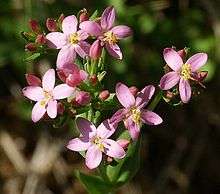Centaurium erythraea
| Centaurium erythraea | |
|---|---|
 | |
| Scientific classification | |
| Kingdom: | Plantae |
| (unranked): | Angiosperms |
| (unranked): | Eudicots |
| (unranked): | Asterids |
| Order: | Gentianales |
| Family: | Gentianaceae |
| Genus: | Centaurium |
| Species: | C. erythraea |
| Binomial name | |
| Centaurium erythraea Rafn | |
| Synonyms | |
|
Erythraea centaurium | |
Centaurium erythraea is a species of flowering plant in the gentian family known by the common names common centaury and European centaury.
Description
This is an erect biennial herb which reaches half a meter in height. It grows from a small basal rosette and bolts a leafy, erect stem which may branch. The triangular leaves are arranged oppositely on the stem and the erect inflorescences emerge from the stem and grow parallel to it, sometimes tangling with the foliage. Each inflorescence may contain many flowers. The petite flower is pinkish-lavender and about a centimeter across, flat-faced with yellow anthers. The fruit is a cylindrical capsule.
It flowers from June until September.
Distribution
This centaury is a widespread plant of Europe (including Scotland, Sweden and Mediterranean countries,[1]) and parts of western Asia and northern Africa. It has also naturalised in parts of North America,[1] and throughout eastern Australia, where it is an introduced species.
Taxonomy
It is also commonly known as “feverfoullie”, “gentian” or “centaury”.[1]
Uses
The European centaury is used as a medical herb in many parts of Europe.The herb, mainly prepared as tea, is thought to possess medical properties beneficial for patients with gastric and liver diseases. Brought to Europe from Peru in c. 1639 by Jesuit priest Bernabé Cobo, it was used in the treatment of malaria long before the widespread use of quinine..
Chemical constituents
Antioxidant ingredients of the centaury are mainly phenolic acids[2] Including ferulic and sinapic acids. The plant also contains amounts of sterols as brassicasterol and stigmasterol.[3] It also contains two secoiridoid glycosides, swertiamarin and sweroside.[1]
External links
References
- 1 2 3 4 Kumarasamy, Y.; Nahar, L.; Cox, P. J.; Jaspars, M.; Sarker, S. D. (2003). "Bioactivity of secoiridoid glycosides from Centaurium erythraea". Phytomedicine. urbanfischer.de. 10: 344–347. doi:10.1078/094471103322004857. Retrieved 7 November 2014.
- ↑ Valentão, P.; Fernandes, E.; Carvalho, F.; Andrade, P. B.; Seabra, R. M.; Bastos, M. L. (July 2001). "Antioxidant Activity ofInfusion Evidenced by Its Superoxide Radical Scavenging and Xanthine Oxidase Inhibitory Activity". Journal of Agricultural and Food Chemistry. 49 (7): 3476–3479. doi:10.1021/jf001145s.
- ↑ http://www.mendeley.com/research/chemical-composition-and-biological-properties-of-erythraea-centaurium-rafn/[]